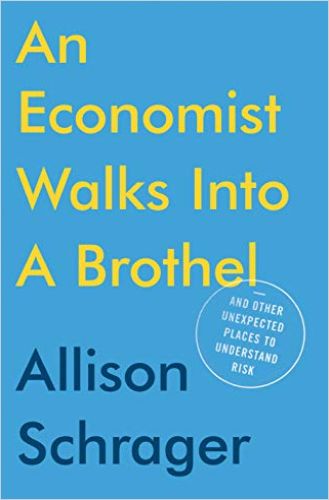Economist Allison Schrager offers eccentric examples of risk management to clarify the concept for laypeople.

Outlier Risk Managment
In this Freakonomics-style look at risk management, Allison Schrager – an economist, a journalist at Quartz, a cofounder of the risk advisory firm LifeCycle Finance Partners and a teacher at New York University – travels far afield to deliver an engaging study of how savvy people manage risk. Her view is a readable and fresh take on an often arcane corner of economics and finance. While not an exhaustive study of risk, Schrager’s breezy tome is a welcome entry in the fast-growing genre of economic analyses for the masses.
Kirkus praised this Financial Times Book of the Month as “a colorful, empowering guide to intelligent risk-taking…[that] breaks the mold of traditional starched-collar, data-dense economics journalism.” The New York Times said that Schrager “emphasizes the importance of getting a good handle on investment risk.”
Risk Management Strategies
Prostitution, Schrager suggests, provides a case study in security and risk mitigation. Street walkers, she notes, die by homicide at a rate 13 times higher than the overall population. But Nevada’s state-sanctioned brothels protect their workers by banning unruly clients.
If we avoid risk, our lives won’t move forward. (Allison Schrager)
Schrager cites, as an example, legal prostitiute Shelby Starr’s gross annual earnings of $600,000 a year, noting that Starr pays 50% of that to her brothel. After taxes, Starr’s take-home pay supports her husband and three children. The safety of the brothel, Schrager underscores, reduces Starr’s risk.
Licit brothels in Nevada, Schrager reports, charge between $360 and $12,000 an hour; clients pay to mitigate the risks of arrest, public shame, blackmail and sexually transmitted disease.
Risk Management Paradox
Big-wave surfers, Schrager discovered, invest in preparation, analysis and risk management, as demonstrated by the Big Wave Risk Assessment Group Safety Summit in Hawaii. Attendees estimate probabilities and learn breath-holding techniques.
Schrager discovers a compelling paradox: Innovations that improve safety encourage risk taking. She explains, for example, that surfboard leashes keep surfers from losing their boards after wipeouts, but, thus protected, weaker swimmers attempt more treacherous waves.
Calamity
Schrager describes the collapse of Long-Term Capital Management (LTCM) in the 1990s. The hedge fund, which Nobelists Robert C. Merton and Myron Scholes co-founded, employed what Schrager points out was a then-novel strategy of increasing returns on bonds through high levels of leverage. The strategy paid off handsomely: LTCM’s after-fees returns hit 40% in 1995 and 1996.
There is no way to make an 80-foot wave safe, and there is no way to make a 25-to-1 leverage ratio risk-free. (Allison Schrager)
Schrager explains how the hedge fund entered 1998 with $4.8 billion in equity capital and $124.5 billion in obligations – a 25-to-1 leverage ratio that Shrager calls the financial equivalent of a monster wave. But in 1998, Russia devalued its currency, and the Asian financial contagion quickly followed. In eight months, LTCM’s $4.8 billion in equity capital plummeted to a measley $2.3 billion. The author recounts how the Federal Reserve Bank of New York – worried that the fund’s failure could spark a Wall Street meltdown – negotiated a $3.6 billion bailout of LTCM.
Loss Aversion
Shrager proffers for study her daily commute – a 30-minute stroll across Manhattan. The bus, she reports, could take 15 minutes or more than an hour to cover the same ground.
Understanding risk and knowing how to take smart risks is a critical life skill, and yet the science of risk is rarely taught.(Allison Schrager)
The author thus reminds you not to ignore wide gaps in possible outcomes, and she provides a parallel for investments: When choosing between two portfolios offering identical returns, Schrager urges you to select the one with less risk.
Lively Style
Schrager writes in a lively, witty style, and she imparts great enthusiasm for her subject. But, as with many contemporary journalists who provide a worthy hook but little substance, Schrager’s book reads like a magazine article padded out to book length.
Thus, readers will find truly fascinating takes on big-wave surfing and prostitution, but they may best appreciate these examples for their eccentric and seldom-explored details and not as guides for investing or understanding risk in other fields. This proves an issue throughout the book: Schrager forces memorable characters and anecdotes into an investment-guidance framework that poorly fits them.
Still, her paint-by-numbers tips on avoiding risk in more classic investment situations will provide laypeople with worthwhile, if superficial, blueprints. In that regard, Brothel may serve as a gateway to more practical investment guides.
A number of narrative-centric books on risk aimed at general readers are available today. Stellar examples of this fast-growing genre include Annie Duke’s Thinking in Bets, Peter L. Bernstein’s Against the Gods, and Terror, Security, and Money by John Mueller and Mark G. Stewart.













